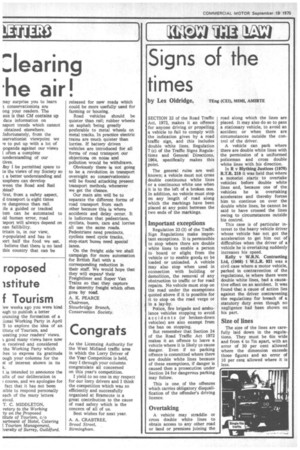Signs of the times
Page 34

If you've noticed an error in this article please click here to report it so we can fix it.
by Les Oldridge, TEng (CEO, MIMI, AMIRTE SECTION 22 of the Road Traffic Act, 1972, makes it an offence for anyone driving or propelling a vehicle to fail to comply with the indication given by a road traffic sign, and this includes double white lines. Regulation 7 (c) of the Traffic Signs Regulations and General Directions, 1964, specifically makes this point.
The general rules are well known; a vehicle must not cross double continuous white lines or a -continuous white one when it is to the left of a broken one In addition, no vehicle must stop on any length of road along which the markings have been placed at any point between the two ends of the markings.
Important exceptions
Regulation 23 (3) of the Traffic Sign Regulations make important exceptions. It is permissible to stop where there are double white lines to enable a person to board or alight from the vehicle or to enable goods to be loaded or unloaded. A vehicle may also stop when used in connection with building or demolition, the removal of any obstruction to traffic or for road repairs. No vehicle must stop on the road under the exemptions quoted above if it is possible for it to stop on the road verge or in a lay-by.
Police, fire brigade and ambulance vehicles stopping to avoid accidents ,(or broken-down vehicles) are also exempt from the ban on stopping.
But remember that Section 24 of the Road Traffic Act 1972 makes it an offence to leave a vehicle where it is likely to cause danger. Even• if no parking offence is committed where there are double white lines because of these exemptions, if danger is caused then a prosecution under Section 24 for dangerous parking may follow.
This is one, of the offences which carries obligatory disqualification of the offender's driving licence.
Overtaking
A vehicle may straddle or cross double white lines to obtain access to any other road or land or premises joining the road along which the lines are placed. It may also do so to pass a stationary vehicle, to avoid an accident or when there are circumstances outside the control of the driver.
A vehicle can park where there are double white lines with the permission of a uniformed policeman and cross double white lines with his direction.
In R v Blything Justices (1970) R.T.R. 218 it was held that where a motorist starts to overtake vehicles before double white lines and, because one of the vehicles he is overtaking accelerates and thereby forces him to continue on over the double white lines, he cannot be said to have crossed the lines owing to circumstances outside his control.
This case is of particular interest to the heavy vehicle driver whose vehicle has not got the acceleration to get him out of difficulties when the driver of a vehicle he is overtaking suddenly increases his speed.
Kelly v W.R.N. Contracting Ltd, (1968) 1 W.L.R. N1 was a civil case where a motor vehicle, parked in contravention of the regulations, ie where there were double white lines, had a causative effect on an accident. It was found that a cause of action lies against the driver contravening: the regulations for breach of a statutory duty even though no negligence had been shown on his part.
Size of lines
The size of the lines are carefully laid down in the regulations. They must be ein wide and from 4 to 7in apart, with an error of 30 per cent allowed where the dimension exceeds those figures and an error of 10 per cent allowed where it is less.
















































































































